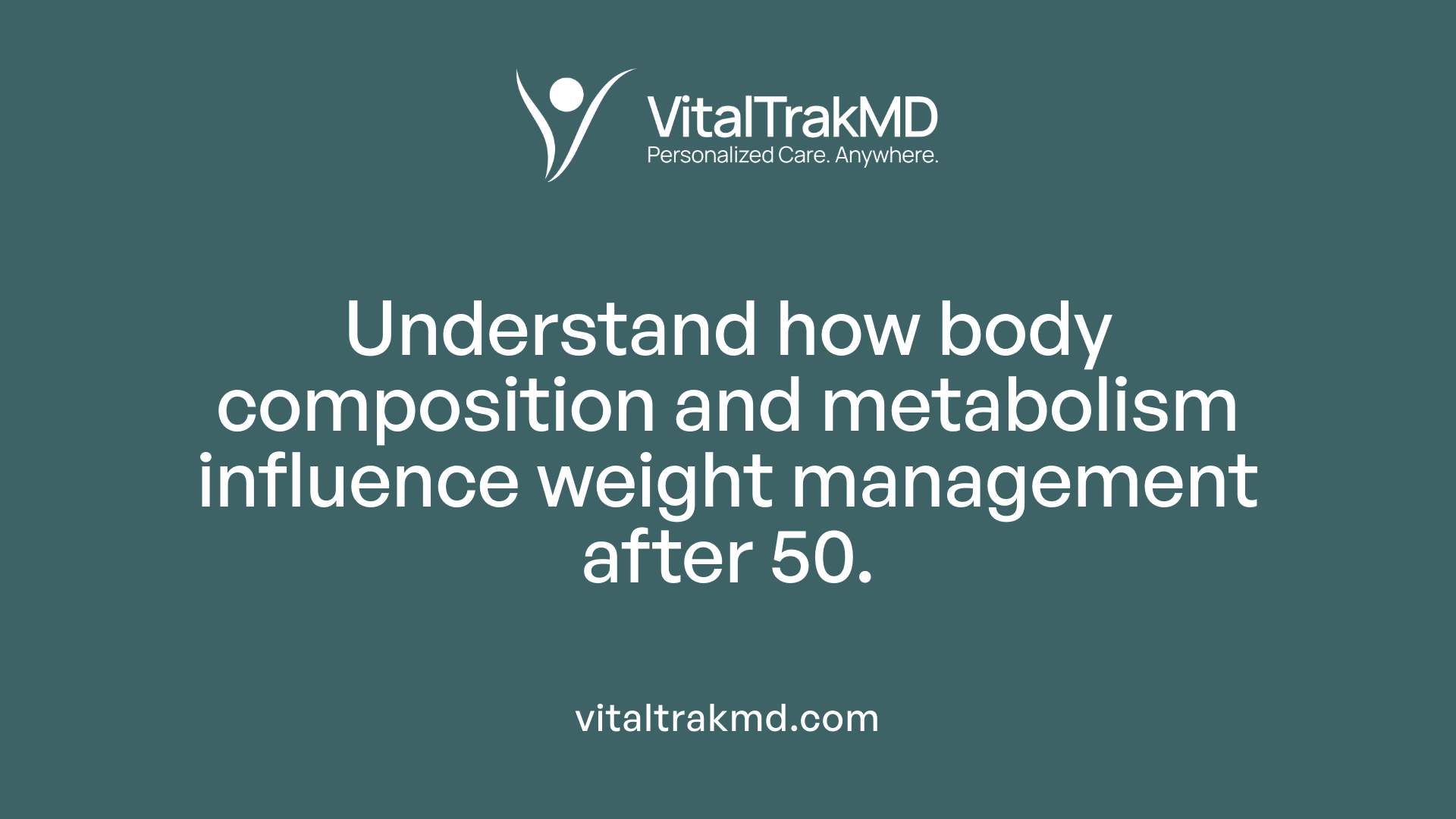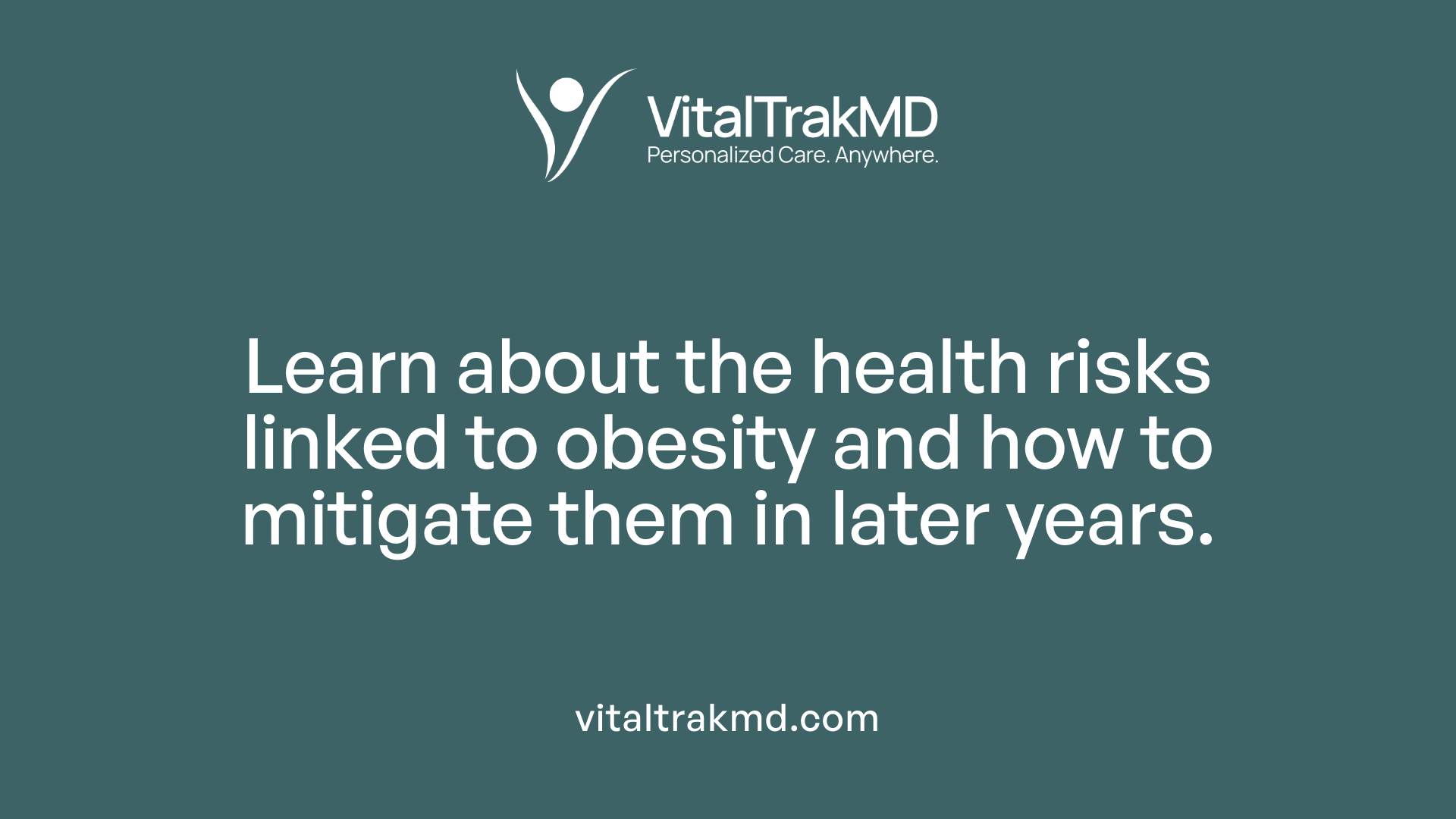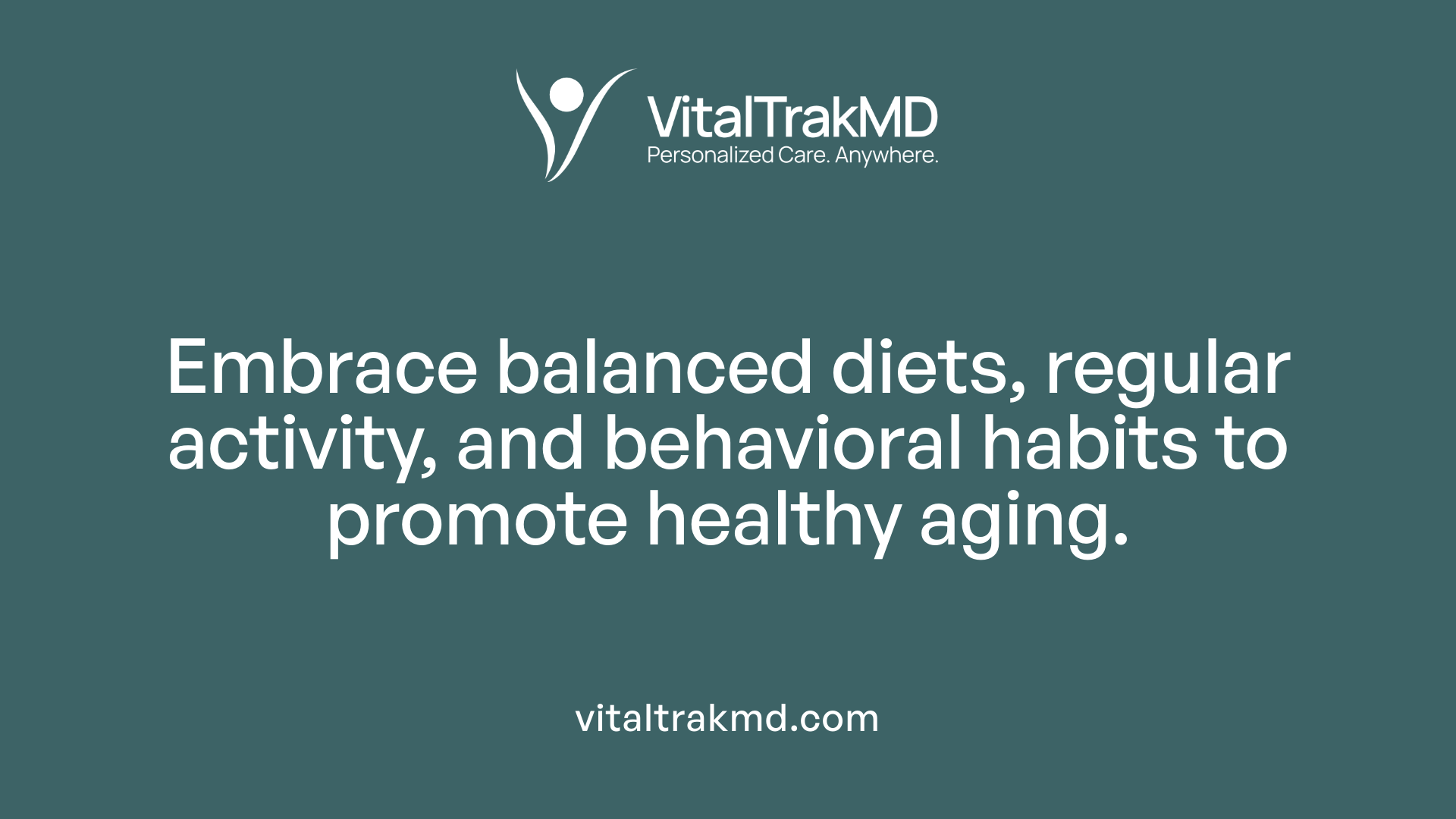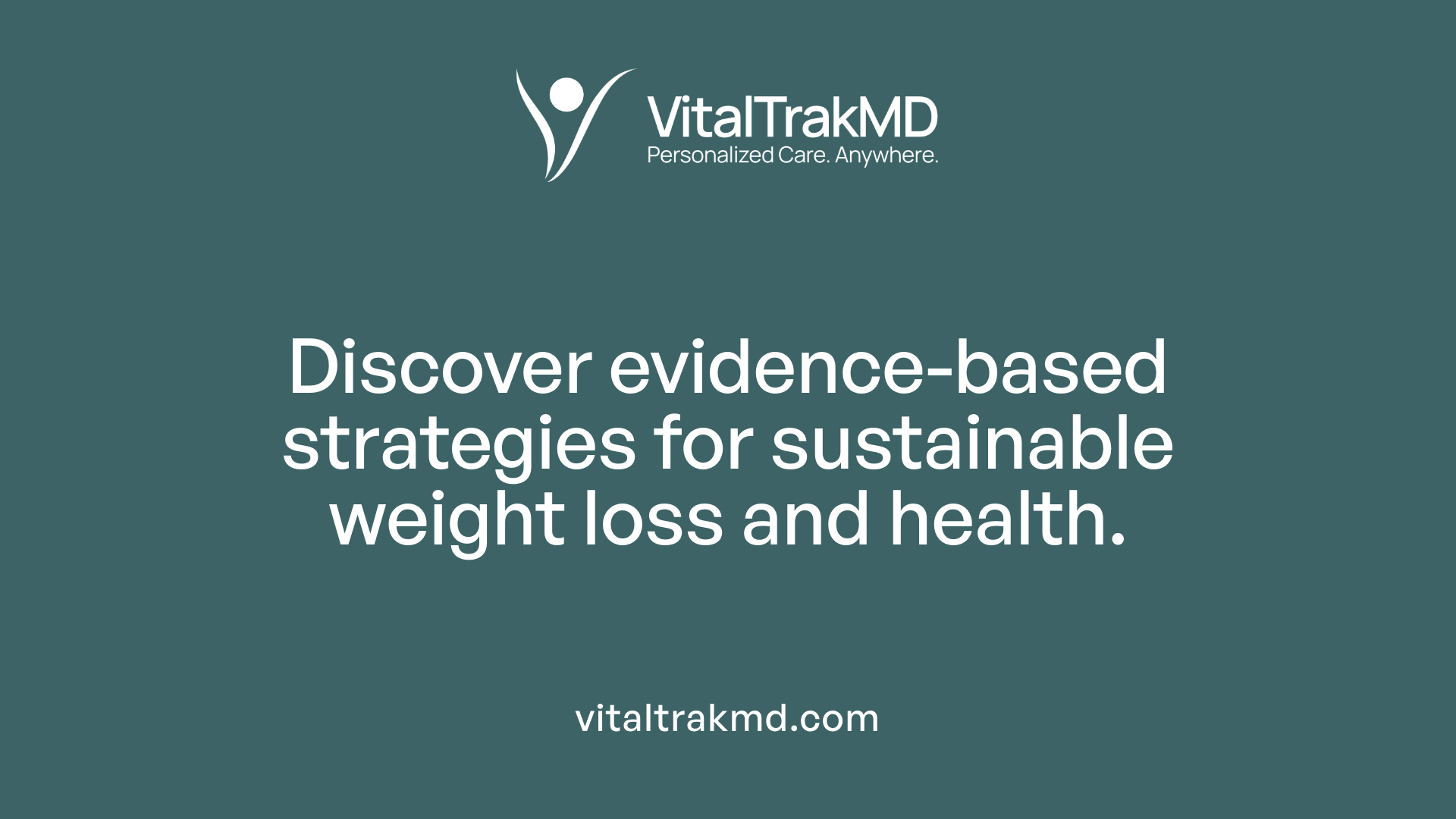The Truth About Weight Loss for Adults Over 50

Navigating Weight Management in Later Life
As we age, maintaining or losing weight becomes increasingly challenging due to physiological, hormonal, and lifestyle changes. This comprehensive guide explores the science behind weight loss in adults over 50, offering practical, evidence-based strategies to help promote healthy aging and improve overall wellbeing.
Physiological Changes Affecting Weight in Older Adults
What are the biological and physiological changes affecting weight loss in adults over 50?
As adults age beyond 50, their bodies undergo several biological and physiological transformations that make weight management more challenging. One of the most notable changes is the decline in muscle mass, which decreases by about 10% around this age. This reduction, known as sarcopenia, diminishes the body's ability to burn calories efficiently, leading to a slower metabolism.
Hormonal fluctuations also play a significant role. Levels of hormones such as estrogen, testosterone, and growth hormone decline with age. Lower estrogen levels, especially in women during and after menopause, lead to fat redistribution, primarily increasing visceral fat around the abdomen. Similarly, reduced testosterone in men results in decreased muscle mass and increased fat accumulation.
In addition to hormonal shifts, body composition tends to shift toward higher fat percentages and reduced lean muscle mass. This shift not only affects the way weight is distributed but also influences overall metabolic rate, further slowing calorie expenditure.
All these changes collectively reduce basal metabolic rate (BMR), which is the number of calories the body requires at rest. A lower BMR means that older adults need fewer calories, and if calorie intake isn't adjusted, weight gain can occur. Understanding these physiological adjustments highlights the importance of strength training, adequate nutrition, and lifestyle adjustments to manage weight effectively after 50.
Effective Strategies for Weight Management in Adults Over 50
As individuals age beyond 50, maintaining a healthy weight requires a multi-faceted approach that combines diet, exercise, and behavioral strategies. Firstly, focusing on a balanced and nutrient-dense diet—such as the Mediterranean or DASH diets—can significantly support weight management. These diets emphasize whole grains, fresh fruits and vegetables, lean proteins like fish and poultry, and healthy fats from nuts and olive oil. Limiting processed foods, sugary snacks, and high-fat red meats further helps reduce calorie intake.
Regular physical activity is crucial. Engaging in at least 150 minutes of moderate aerobic exercise per week, such as brisk walking, swimming, or cycling, enhances calorie burn and cardiovascular health. Equally important is resistance training, which preserves and increases muscle mass that naturally declines with age. Building muscle boosts basal metabolic rate, making it easier to burn calories at rest and aiding in weight loss or maintenance.
Behavioral modifications also play a vital role. Setting specific, measurable, achievable, relevant, and time-bound (SMART) goals helps keep efforts focused. Practicing mindful eating, such as eating slowly and until feeling 80% full, helps prevent overeating. Keeping a food and activity journal can enhance self-awareness and accountability.
Monitoring progress through regular weight checks, body composition analysis, and movement tracking supports sustained motivation. Incorporating social support, whether through exercise groups or family involvement, can improve commitment.
Lastly, it’s essential to consider medical and hormonal influences. Conditions like hypothyroidism, menopause-related hormonal changes, and certain medications may hinder weight loss efforts. Consulting healthcare providers enables personalized strategies that safely address these factors, ensuring a sustainable and effective weight management plan for adults over 50.
Starting the Weight Loss Journey Safely and Effectively

How can older adults effectively start their weight loss journey?
For adults over 50, beginning a weight loss program requires a careful approach. Initial steps should include a thorough medical assessment by healthcare professionals to identify any underlying health conditions such as hypothyroidism or medication effects that could influence weight. This helps tailor a safe and realistic plan.
Implementing a balanced exercise routine is essential. Incorporate resistance training exercises two to three times a week to help preserve muscle mass, which naturally declines with age. Additionally, aim for at least 150 minutes of moderate-intensity cardiovascular activity each week, like brisk walking or cycling.
Diet plays a crucial role. Focus on consuming nutrient-rich foods such as vegetables, fruits, lean proteins, and whole grains. Reducing intake of added sugars, saturated fats, and alcohol supports metabolic health and satiety. Managing stress and ensuring adequate sleep, ideally between 7-9 hours per night, help regulate hunger hormones and promote fat loss.
Staying well-hydrated with water and herbal teas boosts metabolism and helps control appetite. Avoid late-night snacking and practice mindful eating until about 80% full to prevent overeating. Tracking progress with regular weight checks and making small, manageable changes enhances long-term adherence and success.
Impact of Age-Related Body Composition and Metabolism on Weight
 As individuals age past 50, significant changes in body composition and metabolism make weight management more challenging. One of the most notable changes is the accelerated loss of muscle mass, known as sarcopenia. On average, muscle declines by about 1% per year after age 50, which decreases overall calorie-burning capacity because muscle tissue is highly metabolically active.
As individuals age past 50, significant changes in body composition and metabolism make weight management more challenging. One of the most notable changes is the accelerated loss of muscle mass, known as sarcopenia. On average, muscle declines by about 1% per year after age 50, which decreases overall calorie-burning capacity because muscle tissue is highly metabolically active.
Simultaneously, hormonal shifts—such as reductions in estrogen, testosterone, and growth hormone—impact the body's fat distribution. These hormonal changes often lead to increased accumulation of visceral fat around internal organs, especially in the abdomen. This redistribution not only affects body shape but also raises the risk of cardiovascular diseases and metabolic syndrome.
Moreover, the metabolic rate—the amount of energy the body needs at rest—declines with age, primarily due to muscle loss. Originally steady from ages 20 to 60, metabolic rate begins to drop after 60, further complicating weight control efforts. Lifestyle factors, including reduced physical activity and dietary habits, contribute to these changes.
Understanding these biological transformations highlights the importance of targeted strategies. Resistance training can help preserve or rebuild muscle mass, counteracting sarcopenia and supporting a healthy, higher resting metabolic rate. Combining strength exercises with a diet rich in high-quality protein and nutrient-dense foods can effectively manage body composition. These measures not only aid weight management but also reduce the risk of related health conditions, such as diabetes and heart disease.
Here is a summary of how aging impacts body composition and metabolism:
| Aspect | Change with Age | Impact on Weight | Important Strategies |
|---|---|---|---|
| Muscle Mass Decline | About 1% per year after 50 | Decreases calorie burn, promotes fat gain | Strength training, high-protein diet |
| Fat Redistribution | Increased visceral fat, especially in the abdomen | Higher risk for chronic diseases | Regular aerobic activity, balanced diet |
| Metabolic Rate | Declines after 60 | Slower weight regulation | Maintain muscle mass, stay active |
Searching for recent insights on "aging body composition muscle and fat changes" reveals that maintaining muscle mass and managing fat redistribution are crucial for healthy aging. Backed by research, these approaches promote not only weight balance but also overall well-being.
Health Risks Associated with Weight Gain and Obesity in Later Life
 As people age, gaining excess weight can pose serious health threats. In older adults, obesity significantly raises the risk of cardiovascular problems like high blood pressure, stroke, and coronary artery disease. It also increases likelihoods of developing type 2 diabetes, certain forms of cancer, and sleep apnea, which further deteriorate overall health.
As people age, gaining excess weight can pose serious health threats. In older adults, obesity significantly raises the risk of cardiovascular problems like high blood pressure, stroke, and coronary artery disease. It also increases likelihoods of developing type 2 diabetes, certain forms of cancer, and sleep apnea, which further deteriorate overall health.
Beyond disease risk, excess weight can impact mobility and independence. It adds strain on joints, hampers movement, and accelerates muscle and bone deterioration, leading to frailty. This can diminish quality of life and make daily activities more challenging.
An intriguing but debated concept is the 'obesity paradox.' Some studies have shown that higher BMI in older adults may be associated with lower mortality rates. However, this observation is controversial because it might be influenced by confounding factors, such as unintentional weight loss caused by underlying illness in those with normal or low weight. Also, BMI often fails to reflect important aspects like muscle mass or fat distribution, which are more relevant to health than weight alone.
While certain data suggest that being mildly overweight might sometimes seem protective, overall, maintaining a healthy weight through proper diet and regular activity remains crucial. Doing so can reduce the risk of chronic diseases, enhance mobility, and improve overall longevity and well-being.
| Risks of Weight Gain and Obesity | Impact | Nuances |
|---|---|---|
| Cardiovascular disease | Hypertension, stroke, heart disease | Higher fat around abdomen increases risk |
| Type 2 diabetes | Elevated blood sugar levels | Fat tissue causes hormonal imbalances |
| Certain cancers | Breast, colon, endometrial | Obesity linked to higher risk |
| Mobility and independence | Joint strain, frailty | Weight management essential for function |
| Chronic conditions | Sleep apnea, osteoarthritis | Can lead to reduced quality of life |
| Mental health | Depression, anxiety | Body image issues, social isolation |
| The obesity paradox | Apparent lower mortality | Confounded by illness-related weight loss |
| Overall health | Increased inflammation and metabolic strain | Emphasizes importance of holistic health |
Taking steps to manage weight in later years is essential, not only to decrease disease risk but also to maintain independence, mobility, and a better quality of life.
The Role of Diet, Exercise, and Lifestyle Modifications in Promoting Healthy Aging

What scientific research and clinical insights support weight loss after 50?
Research consistently highlights that a combination of dietary changes, increased physical activity, and behavioral strategies are essential for effective weight loss after 50. Diets focusing on whole, unprocessed foods—such as vegetables, fruits, lean proteins, and healthy fats—help increase satiety, reduce calorie intake, and lower the risk of chronic diseases.
Strength training is crucial in preserving muscle mass, which naturally declines with age at about 1-2% annually. Maintaining muscle ensures a higher resting metabolic rate, aiding in weight management.
Behavioral approaches like setting SMART goals, self-monitoring (tracking food and activity), and fostering social support have been shown to improve adherence to healthy routines. Adequate sleep and hydration further support this process, while limiting processed foods, added sugars, and excessive alcohol intake helps prevent overeating and weight gain.
Overall, evidence from clinical trials indicates that focusing on sustainable lifestyle habits can lead to significant health benefits, including reduced risk of obesity-related illnesses, improved mobility, and increased energy levels, even after 50.
How does the Mayo Clinic Diet support weight management in older adults?
The Mayo Clinic Diet offers a practical, long-term approach tailored for adults over 50. It consists of two phases: the initial "Lose It!" phase, which promotes quick weight loss over two weeks, and the ongoing "Live It!" phase, designed to maintain weight and health permanently.
This diet emphasizes large intakes of fruits and vegetables, which are low in calories but high in vital nutrients. It encourages choices from the Mayo Clinic Healthy Weight Pyramid, emphasizing health-promoting foods.
A core component is increasing daily physical activity, recommending at least 30 minutes of movement each day. The program promotes behavioral changes like mindful eating—eating until only 80% full—to prevent overeating and foster a better relationship with food.
By integrating practical strategies such as cooking at home, controlling portion sizes, and staying active, the Mayo Clinic Diet helps older adults manage their weight effectively and reduce health risks associated with obesity, such as cardiovascular disease and diabetes.
| Approach | Focus Area | Details |
|---|---|---|
| Dietary | Whole foods | Vegetables, fruits, lean proteins, healthy fats |
| Exercise | Physical activity | 30+ minutes daily, strength, and cardio training |
| Behavioral | Goal setting & self-monitoring | SMART goals, progress tracking |
| Lifestyle | Avoid processed foods & sugars | Limit alcohol, sugary beverages |
Maintaining a healthy weight after 50 involves a balanced mix of diet, physical activity, and behavioral modifications validated by current research. Such strategies support aging gracefully, enhance daily functioning, and decrease the risk of age-related diseases.
Addressing Risks and Challenges in Long-Term Weight Loss

What are evidence-based approaches for weight loss after 50?
Achieving sustainable weight loss after age 50 requires strategies backed by scientific research. The foundation involves maintaining a nutrient-dense diet with appropriate caloric intake, emphasizing high-quality proteins, fibers, and controlled carbohydrate sources. Consuming sufficient protein is vital to combat age-related muscle loss, or sarcopenia, which slows metabolism and increases frailty.
Regular physical activity combining resistance (strength) training with cardio exercises helps preserve and build muscle mass, supporting a higher resting metabolic rate. Engaging in resistance exercises twice weekly, such as weightlifting or resistance band workouts, can offset muscle decline.
Behavioral techniques are equally important. These include self-monitoring food intake, setting realistic and specific goals, and establishing routines that foster accountability. Mindful eating practices—paying attention to hunger cues and stopping at about 80% fullness—can prevent overeating.
Addressing age-related hormonal and metabolic changes is crucial. Adequate Vitamin D and sufficient protein intake support muscle health, while managing glycemic load through dietary choices aids metabolic stability. Sleep hygiene and hydration also play significant roles in weight management.
Continuous support from healthcare providers can identify underlying health issues like hypothyroidism or other hormonal imbalances that hinder weight loss.
In summary, a comprehensive approach combining diet, exercise, behavioral techniques, and medical guidance provides the best chance to succeed in long-term weight management after 50. It not only helps in weight reduction but also improves overall health, mobility, and quality of life.
Additional Insights
Research emphasizes that focusing solely on weight loss is less effective than monitoring body composition, particularly muscle mass versus fat. Strategies that include resistance training and nutritional support have demonstrated improvements in physical function, metabolic health, and chronic disease risk reduction.
For older adults, sustained lifestyle changes such as regular physical activity, balanced eating, adequate sleep, and hydration are essential for long-term success. Maintaining motivation might involve social support, such as group exercise or working with a coach, which can enhance commitment.
Ultimately, understanding and addressing the unique biological and physiological changes of aging—like hormonal shifts and muscle decline—is fundamental to developing achievable, health-oriented weight management plans.
Achieving and Sustaining a Healthy Weight in Later Life
While aging introduces unique challenges to weight management, understanding the biological and physiological changes involved allows for more effective strategies. Incorporating regular strength and aerobic exercises, maintaining a balanced diet rich in nutrient-dense foods, and adopting behavioral habits like goal setting and self-monitoring can significantly improve health outcomes. Personalized approaches, professional guidance, and a focus on sustainable lifestyle changes are key to achieving lasting weight management and enhancing quality of life in later years. Embracing these practices not only reduces the risks associated with obesity but also empowers adults over 50 to enjoy active, independent, and healthy lives.
References
- Losing Weight After 50: Top 20 Expert Tips - AARP
- The 20 Best Ways to Lose Weight After 50 - Healthline
- The Mayo Clinic Diet: A weight-loss program for life
- Why is it so hard for women over 50 to lose weight?
- Weight Management in Older Adults - PMC - PubMed Central
- Intermittent Fasting for Women Over 50: What You Need to Know
- Why is it hard to lose weight after 50? - HCF
- Weighing the Facts: The Tough Truth About Weight Loss
Recent articles
Want to Feel Better and Live Healthier?
Join hundreds of patients taking control of their health with personalized care that fits their life – not the other way around.
Rated 4.8/5 by 32+ customers







